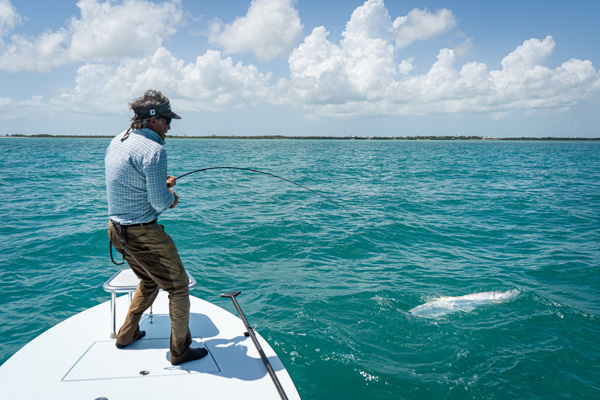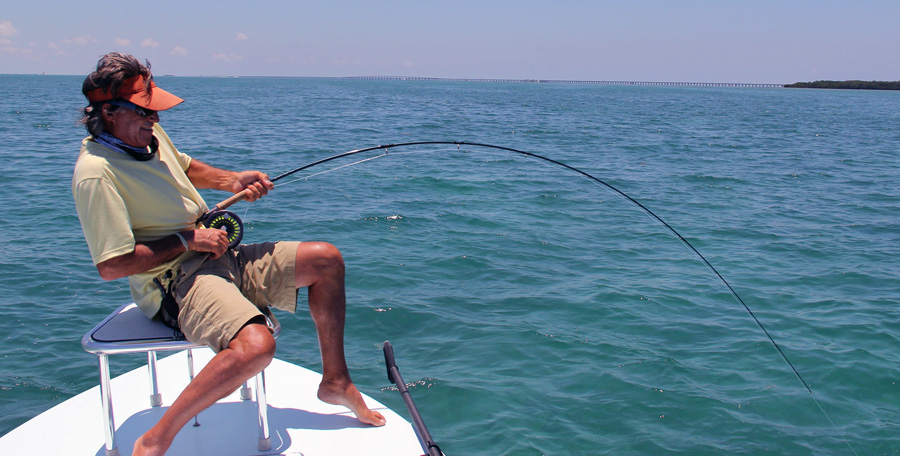We’ve all been there before, hooked into a leviathan for more than an hour. Your arms are smoked out, your clothes are drenched, and you’re hoping it breaks off sooner than later—and yet you don’t want to lose it.
Your guide is encouraging, “Come on. You’ve got this. Pull harder now.”
No, you don’t have “this.” Your mental composure was gone 45 minutes ago. In reality, you never really grasped the fact that this fish has been a survivor for 100 million years, it’s a 140-pound tarpon, close to 60 years old, and it thinks it’s going to die.
As neophytes, we have to understand a couple of things about how to successfully subdue huge fish. First, when we finally get the fish of our dreams on and we don’t want to lose it, we’ll never really fight it with all we’ve got. There’s no way we’re going to pull hard enough to take the chance of breaking it off. Second, we really have no idea how to pull hard or even what the limit is. When your guide says “pull harder,” most anglers probably just lean back and put a bigger bend in the rod. Wrong.
The key to catching big fish with excessive power is understanding not only how hard you can pull on that fish with the class tippet you’re using, but also understanding the anatomical ability of your fly rod as well as your body.
The tip of a fly rod is used for short casts, the middle is for medium to longer casts, and the butt is used for fighting fish. Your body is similar to the rod, with some parts capable of extreme power and other parts more suitable for feel and lighter resistance. If you misuse the rod or your body—and usually it’s both at the same time—the catch you’re hoping for is highly unattainable.
Here’s an example: Leaning back with a high, big bend in your rod while trying to subdue a big fish does nothing more than bend the tip, which has zero resistance. It looks good to those who know nothing about the subject. But trust me—it’s useless. That’s why anglers end up fighting fish for an hour and sometimes much longer. That can also kill a fish because of the high levels of lactic acid that build up during long battles.
There is a place for fighting fish with a high, bent rod tip. When trout fishing with light 7x and 8x tippets, or saltwater fishing with 2-, 4-, and 6-pound-test tippets, the sensitive tip will help absorb the energetic thrashing of a fish. But that’s not our scenario here.
It’s also impossible to put a big bend in the upper part of the rod without using your biceps. That single biceps muscle holding and lifting the rod will grow fatigued in no time if you’re trying to apply 12 pounds of pressure or more. If you reach up with the other hand to the mid-section of the rod to help, you’ll change the fulcrum and break the rod.
You must learn to use the butt of the rod and lift with your legs, shoulders, and back. If you lift the rod higher than 45 degrees from the water level, your biceps comes into play. To bend the rod, you have to bend the elbow.
Most of the class tippets I’ve used for the last 35-plus years catching tarpon have been 16-pound Mason. I used 16 because the biggest tournament in the world required anglers to use it, and I wanted to keep my feel for that class of line.

International Game Fish Association (IGFA) fly fishing rules require anglers to use 20-pound test or lighter; even offshore marlin anglers are confined to this guideline. Tom Evans caught his 273-pound blue marlin on 16-pound test—one of the greatest fly records of all time.
For all those guides and anglers who use 30- and 40-pound test, I challenge you to the blindfold test. Take four rods with 20-, 30-, 40-, and 60-pound-test tippets and connect them to a scale. Stand back and pull with a fish-fighting rod position—not a straight rod—for 15 minutes, and see what the scale reads. I suspect none of the rods will pull more than 12 to 18 pounds.
You may escape a bad mistake fishing with 40-pound class, but you’ll never pull harder than what I just mentioned, and over time it will prevent you from becoming a better angler.
I wrote about understanding reel drag and marking your reel with Sharpies or paint in our last issue. But there’s even more to consider. When you measure drag resistance with your line coming straight off the reel, you get a clean number before you start to bend the rod as if fighting a fish. If you measure how much friction and resistance your guides create with a well-bent rod, it’s about 20 percent more than with a straight rod. So if your drag is set at 10 pounds, it’ll now take 12 pounds to pull line off the reel.
It’s important to understand that your drag setting doesn’t accurately represent what you think it does when you compare the preset value to a fish-fighting scenario. A fairly straight rod angle to the fish will be pretty close to your drag setting.
If you want to take the guesswork out of it, you can also set your drag with your rod bent in a fish-fighting angle. You don’t want to set your drag too close to the breaking strength of your tippet. You need to have a little room for error and the fish’s first run.
If you have a tight drag and you have to clear 30 feet of fly line before you get the fish on the reel, there’s a good chance he’ll break when that slack is gone and it hits a tight drag. And if the drag is set too close to the breaking point and a 100-pound fish falls on your leader, it’s over.
The fly rod and your body need to work together, so I want to tell you about the greatest fish-fighting tip I know. This drill matches up your weak and strong body parts, as well as those of the rod. It’s a revelation that will make you a better angler.
Subscribe to Read the Full Article…
Your print subscription includes the digital version which gives you access to dozens of back issues
TFFM Consulting Editor, Andy Mill, is one of fly fishing’s leading authorities. He has won more invitational tarpon tournaments than any other angler, including five Gold Cups. Andy is the author of A Passion for Tarpon (Wild River Press). You can listen to the fly fishing podcasts produced by him and his son Nicky at millhousepodcast.com.



